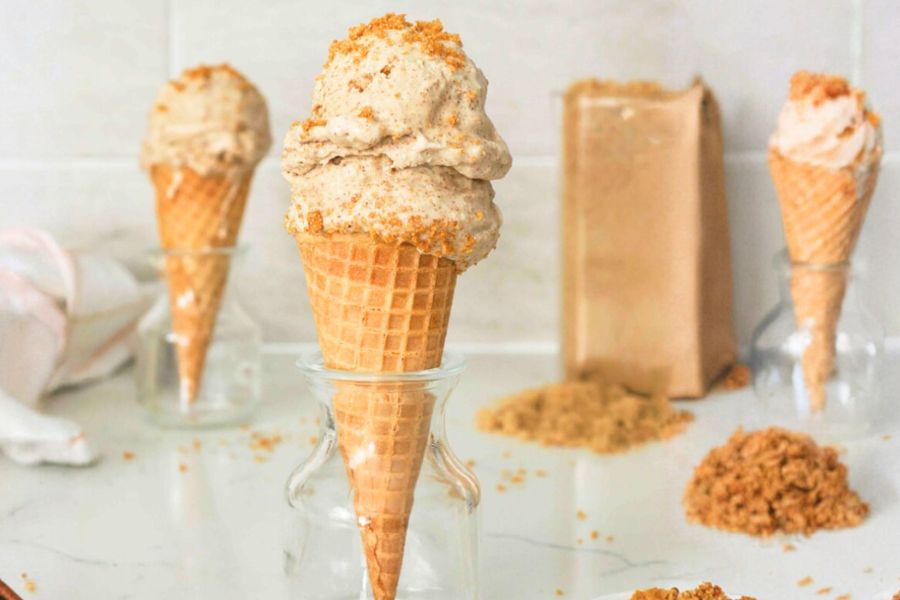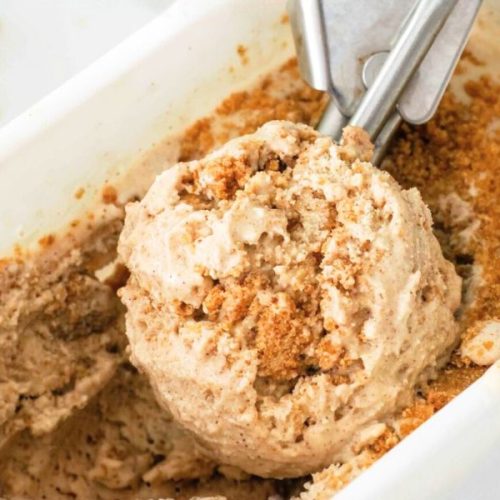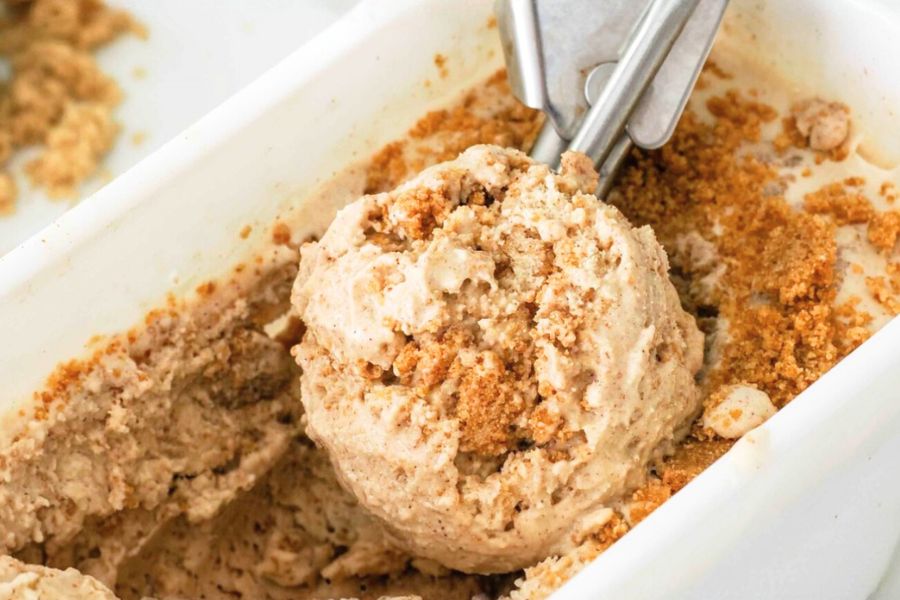This Brown Sugar Cinnamon Ice Cream recipe stands out with its rich, warm flavors and the delightful contrast of a crunchy, salted graham cracker ripple.
The combination of brown sugar and cinnamon creates a cozy, nostalgic taste that’s perfect for any season.
Beyond indulgence, this ice cream offers moderate protein from the egg yolks and whole milk, contributing to satiety and muscle support.

The use of real ingredients like heavy cream and cinnamon adds good fats and antioxidants, while the homemade graham cracker ripple introduces fiber and a satisfying texture.
It’s a fantastic everyday treat because it balances indulgence with nourishment and doesn’t rely on artificial flavors or preservatives.
Plus, the recipe is ideal for meal prep — make the custard ahead, churn, and freeze, ensuring a fresh homemade dessert whenever you crave it.
Must-Have Tools for Perfect Results:
Cuisinart Ice Cream Maker Machine, 1.5 Quart
Essential for churning the custard into creamy, smooth ice cream with professional consistency. This durable, easy-to-use machine is perfect for all homemade frozen desserts, helping you create endless treats effortlessly.
Food Processor
Crucial for crushing graham crackers finely and mixing the ripple ingredients evenly. Beyond this recipe, a food processor saves time in chopping, pureeing, and mixing for countless cooking tasks.
Heavy-Duty Whisk
Perfect for whisking egg yolks to the ribbon stage and combining custard ingredients smoothly. A high-quality whisk ensures efficient mixing and can be used daily for sauces, batters, and dressings.
Heat-Safe Mixing Bowl
Necessary for tempering eggs and chilling the custard. Its heat resistance allows safe handling of hot mixtures, making it versatile for baking, marinating, and prepping ingredients.

Crunchy Brown Sugar Cinnamon Ice Cream
Equipment
- 1 medium pot
- 1 heat-safe mixing bowl
- 1 Whisk
- 1 Food Processor
- 1 ice cream maker (1.5 quart capacity)
Ingredients
For the Brown Sugar Cinnamon Ice Cream:
- ¾ cup 160 g packed brown sugar
- 1 ½ cups 350 ml heavy cream
- 1 ½ cups 350 ml whole milk
- 2 teaspoons ground cinnamon
- Pinch of salt
- 4 large egg yolks
- 1 teaspoon vanilla bean paste or vanilla extract
For the Graham Cracker Ripple:
- 7 sheets 115 g graham crackers
- 2 teaspoons granulated sugar
- ¼ teaspoon salt
- ¼ teaspoon ground cinnamon
- 4 tablespoons 42 g salted butter, melted
Instructions
- Prepare the Brown Sugar Cinnamon Cream Base: Begin by combining half of the brown sugar (about ⅓ cup or 80 grams), heavy cream, whole milk, ground cinnamon, and a small pinch of salt in a medium-sized saucepan. Place the pot over medium heat and gently warm the mixture. Stir occasionally using a heat-resistant spoon or spatula to prevent the milk from scorching on the bottom. Heat for approximately 8 to 10 minutes until the mixture becomes hot and steamy but not boiling. You might notice some cinnamon floating on top—that’s perfectly fine and part of the flavor infusion.
- Whisk Egg Yolks with Brown Sugar to the Ribbon Stage: While the cream mixture is warming, take four large egg yolks and the remaining half of the brown sugar in a large, heatproof mixing bowl. Using a sturdy whisk, beat the yolks and sugar together vigorously for about one minute. Your goal is to achieve what is called the “ribbon stage,” where the mixture thickens enough to leave visible trails when you lift the whisk. This texture indicates the yolks have aerated sufficiently and will create a silky custard.
- Temper the Egg Yolks to Avoid Curdling: Once the cream mixture is hot, it’s time to slowly combine it with the egg yolks without cooking them too quickly. To do this, carefully ladle 1 to 2 tablespoons (15–30 ml) of the warm cream into the yolk mixture, whisking constantly and vigorously to gradually raise the temperature of the yolks. Repeat this process 3 to 4 times, always adding small amounts and whisking until fully incorporated. This gentle warming prevents the eggs from scrambling and ensures a smooth custard.
- Cook the Custard Until Thickened: Pour the tempered egg yolk mixture back into the saucepan with the remaining cream mixture. Return the pot to medium heat and cook gently, stirring often with a wooden spoon or silicone spatula to keep the custard moving and prevent sticking. Continue cooking for 5 to 10 minutes, monitoring the temperature closely. The custard is ready when it thickens enough to coat the back of a spoon and reaches about 170°F (75°C). Be careful not to let it boil; boiling can cause the eggs to curdle.
- Add Vanilla and Chill the Custard: Remove the custard from heat and pour it back into your heat-safe bowl if you used a different pot. Stir in 1 teaspoon of vanilla bean paste or vanilla extract, which enhances the rich flavors. Cover the bowl tightly with plastic wrap, pressing it directly onto the surface of the custard to prevent a skin from forming. Refrigerate the custard for at least 4 hours or up to one day to allow it to cool thoroughly and develop flavor.
- Prepare the Graham Cracker Ripple Mixture: While the custard chills, make the graham cracker ripple. Break the 7 graham cracker sheets into smaller pieces and place them in a food processor. Pulse until they are finely crushed into crumbs. Transfer the crumbs to a bowl and mix in the granulated sugar, salt, and cinnamon evenly. Pour the melted salted butter over the dry mixture and stir or pulse again briefly to coat the crumbs completely. The mixture should hold together slightly when pressed.
- Freeze the Graham Cracker Ripple: Line a small baking sheet with parchment paper. Spread the graham cracker mixture evenly over the sheet, aiming for about a ¼-inch (6 mm) thickness. It doesn’t have to cover the entire sheet edge-to-edge, but should be spread thin enough for bite-sized chunks once frozen. Cover the sheet with plastic wrap and place it in the freezer while you prepare the ice cream base.
- Churn the Custard into Ice Cream: Ensure your ice cream storage container is chilled by placing it in the freezer beforehand. Pour the fully chilled custard into the bowl of your ice cream maker and churn according to the manufacturer’s instructions. This process typically takes about 20 minutes, during which the custard will transform into thick, creamy ice cream with a smooth texture.
- Incorporate the Graham Cracker Ripple: In the final few minutes of churning, remove the graham cracker mixture from the freezer. Using a spatula or clean hands, break it into small, bite-sized pieces. When the ice cream is almost done, layer it in your chilled container: start with about one-third of the ice cream, sprinkle a handful of the graham cracker pieces on top, then add another layer of ice cream followed by more cracker pieces. Repeat until all ice cream and crumbs are used. Use a spoon or butter knife to gently swirl the layers by moving it side to side and up and down the container to distribute the ripple without fully mixing it in.
- Freeze Until Firm or Serve Soft Serve Style: For a soft serve experience, enjoy the ice cream immediately after churning. Otherwise, cover the container with a tight-fitting lid or plastic wrap and freeze the ice cream for at least 4 hours. This step firms up the texture, making it perfect for slicing into scoops later. For best taste and texture, consume within one week.
Notes
- When warming the cream and milk mixture, it should be hot and steamy but not boiling to preserve the delicate flavors and prevent curdling.
- Whisk the egg yolks and brown sugar until thick enough to coat the back of a spoon; this step is crucial to a smooth custard.
- Gradually add the warm cream mixture to the eggs to temper them—adding too fast can scramble the yolks.
- Cook the custard gently, stirring constantly, until it thickens enough to coat a spoon and reaches about 170°F (75°C); avoid boiling to prevent curdling.
- If any curdling occurs, strain the custard through a fine mesh sieve to remove lumps before chilling.
- For the graham cracker ripple, crushing and mixing the crackers with sugar, cinnamon, and melted butter before freezing creates a crunchy, flavorful contrast.
- Layer the churned ice cream and graham cracker pieces to achieve a delicious ripple effect; swirling gently helps distribute the bits evenly.
- For best texture and flavor, freeze the ice cream for at least 4 hours before serving; consume within one week for optimal freshness.
Chef’s Secrets for Creamy Perfection
Achieving a perfectly creamy and flavorful ice cream begins with careful temperature control and patience.
When warming your cream and milk mixture, avoid boiling to prevent curdling the eggs.
Tempering the yolks slowly with small additions of warm liquid is key to a smooth custard base. Use a high-quality vanilla bean paste for a richer, more complex flavor than standard vanilla extract.
For the graham cracker ripple, finely crushing the crackers ensures each bite delivers a consistent crunch without overpowering the creamy texture.
When layering your ice cream and ripple, don’t over-swirl; a gentle fold maintains distinct ribbons of flavor and texture. Finally, chilling the custard thoroughly before churning enhances the final consistency and depth of flavor.
Serving Suggestions to Impress Guests
This brown sugar cinnamon ice cream pairs beautifully with a variety of desserts and snacks.
Serve it alongside warm apple pie or pear crisp for a cozy, fall-inspired treat. For a lighter option, top a bowl of fresh berries or poached peaches with a scoop, allowing the cinnamon and graham notes to complement the fruit’s natural sweetness.
Garnish with a sprinkle of ground cinnamon or a drizzle of honey to elevate the presentation.
It also works wonderfully as a creamy topping for coffee or hot chocolate, adding a sweet and spiced twist.
For casual gatherings, offer cones or small cups with extra graham cracker crumbs for added texture.
Storage Tips for Freshness and Flavor
To preserve the ice cream’s creamy texture and vibrant flavor, store it in an airtight container in the coldest part of your freezer.
Pressing a piece of plastic wrap directly onto the ice cream’s surface before sealing helps prevent ice crystals from forming.
Avoid frequent temperature fluctuations by keeping the freezer door closed during storage.
Consume the ice cream within one week for the best taste and texture, as homemade ice cream lacks the stabilizers found in commercial varieties.
If the ice cream becomes too firm after long storage, allow it to sit at room temperature for 5–10 minutes before scooping for easier serving.
Frequently Asked Questions Answered Clearly
- Can I use a different type of milk?
Yes, you can substitute whole milk with 2% or even plant-based milks like oat or almond, but keep in mind this will alter the creaminess and flavor profile slightly. - What if I don’t have an ice cream maker?
You can still make this recipe by freezing the custard in a shallow container and stirring every 30 minutes to break up ice crystals until fully frozen, though the texture won’t be as smooth. - How do I know when the custard is thick enough?
The custard should coat the back of a spoon and leave a clear line when you run your finger through it. It will also thicken noticeably as it cools. - Can I prepare the graham cracker ripple in advance?
Absolutely! The ripple can be made and frozen for up to one month ahead, making this recipe perfect for meal prep or last-minute dessert plans. - Why did my custard curdle, and how do I fix it?
Curdling happens if the custard overheats or the eggs cook too quickly. If this occurs, simply strain the mixture through a fine mesh sieve to remove lumps before chilling.
This recipe has been adapted and simplified from the original version by floralapron. We’ve refined the steps for a smoother cooking experience and added helpful notes, nutrition insights, and essential kitchen tools to make it even easier for home cooks.

